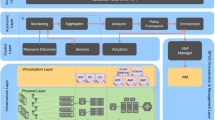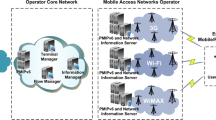Abstract
A key challenge for the management systems of future networks is the reduction of human interventions in the fundamental management functions. These include mechanisms that render the networks capable to configure, optimize, heal and protect itself, but also handle the emerging complexity. Demands for the future internet networks mandate the rapid assessment of the feasibility of such cognitive management architectures that shall bridge the gap between conceptual design and practical network deployments. In this paper, a novel architecture is introduced, based on organized distribution of control feedback cycles at locations allocated across network’s operational elements. Two realisations of self-management in the operations of wired and wireless access network segments are presented. The first one is focused on organization of the wireless access regions in networks by the use of compartments of access points for enabling coverage optimization. A compartment-based approach facilitates the more efficient usage of network resources, exploiting local situation awareness and local optimisation features, according to the varying traffic needs. The second realization shows the control of mobility management processes in wired parts of access networks for balancing utilization of network resources. A dynamic deployment and re-configuration of mobility agents permit to tackle the problem of congestion induced by mobility agents in mobile protocols and combined with a dynamic access router assignment, network resources are efficiently balanced within the network. The paper concludes with findings and recommendations on how common principles of self-management evolve from design theory to practice.



















Similar content being viewed by others
References
Agoulmine, N., et al. (2006). Challenges for autonomic network management. In 1st IEEE international workshop on modelling autonomic communications environments (MACE), Ireland.
Ballani, H., & Francis, P. (2007, October ). CONMan: A step towards network manageability. ACM SIGCOMM Computer Communication Review, 37(4), 205–216.
Boite, J., Nguengang, G., Israel, M. & Conan, V. (2010) CONEMAF: A modular multi agent framework for autonomic network management. In 2nd International conference on agents and artificial intelligence (ICAART), Spain.
Chaparadza, R. (2008). Requirements for a generic autonomic network architecture (GANA), suitable for standardizable autonomic behavior specifications for diverse networking environments (Vol. 61). In International engineering consortium (IEC) annual review of communications.
Chaparadza, R., Papavassiliou, S., Kastrinogiannis, T., Vigoureux, M., et al. (2009). Creating a viable evolution path towards self-managing future internet via a standardizable reference model for autonomic network engineering. FIA conference, Czech Republic. (Published in the FI Book produced by FIA).
Derbel, H., Agoulmine, N., & Saläun, M. (2009). ANEMA: Autonomic network management architecture to support self-configuration and self-optimization in IP networks. Elsevier Computer Networks, 53(3), 418–430.
ETSI Standardinsation Group. Autonomic network engineering for the self-managing future internet—AFI. http://portal.etsi.org/portal/server.pt/community/AFI/344.
EU Project BIONETS, Deliverable D1.1.1. (2007, July) Application scenario analysis, network architecture requirements and high-level specification. http://www.bionets.eu.
EU project UNIVERSELF, INFSO-ICT-257513. http://www.univerself-project.eu/.
Foley, C., et al. (2008). A framework for in-network management in heterogeneous future communication networks. In Conference on modelling autonomic communication environment (MACE), Greece.
Galis, A. et al. (2009, April). Management architecture and systems for future internet networks. Towards the future internet—A European research perspective. Washington, D.C.: IOS Press. ISBN:978-1-60750-007-0.
Greenberg, A., et al. (2005). A clean slate 4D approach to network control and management. SIGCOMM Computer Communication Review, 35(5), 41–54.
Gundavelli, S., & Leung, K. (2008, August) Proxy mobile IPv6, RFC 5213.
Haratcherev, I., Fiorito, M., & Balageas, C. (2009). Low-power sleep mode and out-of-band wake-up for indoor access points. In IEEE global communications conference (GLOBECOM) workshops, USA.
IBM. (2003). An architectural blueprint for autonomic computing.
Jennings, B., Van der Meer, S., Balasubramaniam, S., et al. (2007). Towards autonomic management of communications networks. IEEE Communications Magazine, 45(10), 112–121.
Keszei, C., Georganopoulos, N., Tyranyi, Z., & Valko, A. (2001). Evaluation of the BRAIN candidate mobility management protocol. Germany: IST Mobile Summit.
Kousaridas, A., Mihailovic, A., & Alonistioti, N. (2010). Dynamic compartment formation for coverage optimization of cognitive wireless networks. In IEEE symposium on personal, indoor, mobile and radio communications (PIMRC), Turkey.
Lorincz, J., Capone, A., & Bogarelli, M. (2010, May). Energy savings in wireless access networks through optimized network management. In Proceedings of IEEE ISWPC, Modena, Italy, pp. 449–454.
Manzalini, A., & Zambonelli, F. (2006). Towards autonomic and situation-aware communication services: The CASCADAS vision. In IEEE workshop on distributed intelligent systems: Collective intelligence and its applications (DIS’06), Czech Republic.
Mihailovic, A., Nguengang, G., Borgel, J., & Alonistioti, N. (2009). Building knowledge lifecycle and situation awareness in self-managed cognitive future internet networks. In 1st International conference on emerging network intelligence (EMERGING), Malta.
Mihailovic, A., et al. (2009). Architectural principles for synergy of self-management and future internet Evoelution. Spain: ICT Mobile Summit.
Mortier, R., & Kiciman, E. (2006). Autonomic network management: Some pragmatic considerations. ACM SIGCOMM workshop on internet network management (INM), USA.
Muscariello, L., Perino, D., & Rossi, D. (2009) Do next generation networks need path diversity? In IEEE International conference on communications (ICC).
Nolte, K., Kaloxylos, A. Tsagkaris, K., Rosowski, T., Stamatelatos, Galani, A., et al. The E3 architecture: Enabling future cellular networks with cognitive and self-x capabilities. International Journal of Network Management, 21(5), 360–383.
Pack, S., Kwon, T., & Choi, Y. (2007, April) A performance comparison of mobility anchor point selection schemes in hierarchical mobile Ipv6 networks. The International Journal of Computer and, Telecommunications, 51(6), 1630–1642.
Pentikousis, K., Meirosu, C., Miron, A., & Brunner, M. (2009). Self-management for a network of information. In ICC Communications Workshops, ICC Workshops, Germany.
Pragad, A. D., Friderikos, V., & Aghvami, A. H. (2008). Optimal configuration of mobility agents in broadband wireless access networks. In IEEE global communications conference (GLOBECOM) workshops, USA.
Pragad, A.D., Friderikos, V., Pangalos, P. & Aghvami, H. (2007) The impact of mobility agent based micro mobility on the capacity of wireless access networks. In IEEE global telecommunications conference, 2007 GLOBECOM ’07, 26–30 November 2007, pp. 4994–4999.
Pragad, D., Jaron, A., Pangalos, P., & Aghvami, A. H. (2011, October). Dynamic mobility anchor selection mechanism with QoS constraints. Communications Letters, IEEE, 15(10), 1094–1096.
Prakash, R., Chaparadza, R., & Theisz, Z. (2010). Requirements of a model-driven methodology and tool-chain for the design and verification of hierarchical controllers of an autonomic network. In 3rd International conference on communication theory, reliability, and quality of service, Greece, 2010.
R’etv’ari, G., N’emeth, F., Chaparadza, R., & Szab’o, R. (2009) Ospf for implementing self-adaptive routing in autonomic networks: A case study. In Conference on modelling autonomic communications environments (MACE), Italy.
Samdanis, K., Taleb, T., Kutscher, D., et al. (Feb. 2012). Self organized network management functions for energy efficient cellular urban infrastructures. Journal of Mobile Networks and Applications, 17(1), 119–131.
Schank, T., & Wagner, D. (2005). Approximating clustering coefficient and transitivity. Journal on Graph Algorithms and Applications, 9, 265–275.
Schuetz, S., Zimmermann, K., Nunzi, G., Schmid, S., & Brunner, M. (2007). Autonomic and decentralized management of wireless access networks. IEEE Transactions on Network and Service Management, 4(2), 96–106.
Self-NET EU Project, Deliverable D4.3. (2010, November). Final report on self-NET distributed validation environment, INFSO-ICT-224344. https://www.ict-selfnet.eu.
Smirnov, M., Zseby, T., & Roth, R. (2006). Situation-aware composition of low-level traffic handling functions. In Conference on modelling autonomic communications environments (MACE), Ireland.
SOKRATES EU Project Deliverable D5.10. (2010, October) Measurements, architecture and interfaces for self-organising networks. INFSO-ICT-216284 SOCRATES. http://www.fp7-socrates.org.
Tcholtchev, N., Chaparadza, R. & Prakash, A. (2009) Addressing stability of control-loops in the context of the GANA architecture: Synchronization of actions and policies. In 4th IFIP TC 6 international workshop on self-organizing systems (IWSOS). Germany, Heidelberg: Springer, pp. 262–268.
Yemini, Y., Konstantinou, A., & Florissi, D. (2000). NESTOR: An architecture for network self-management and organization. IEEE Journal on Selected Areas in Communications, 18, 758–766.
Author information
Authors and Affiliations
Corresponding author
Rights and permissions
About this article
Cite this article
Mihailovic, A., Kousaridas, A., Jaron, A. et al. Self-Management for Access Points Coverage Optimization and Mobility Agents Configuration in Future Access Networks. Wireless Pers Commun 72, 343–374 (2013). https://doi.org/10.1007/s11277-013-1017-z
Published:
Issue Date:
DOI: https://doi.org/10.1007/s11277-013-1017-z




